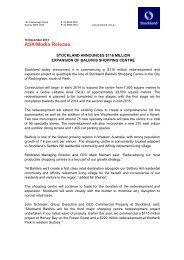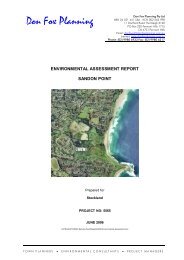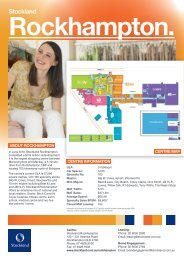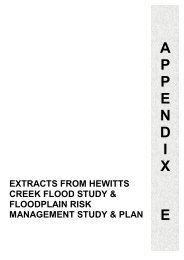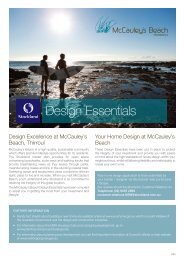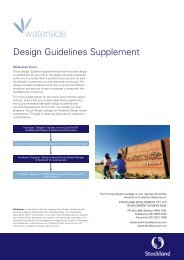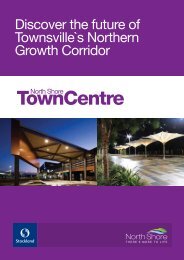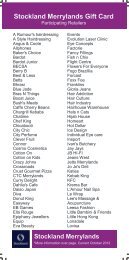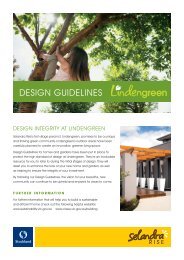OUR CUSTOMERSAND SUPPLIERSRESPONDING TO OUR CUSTOMERS– RESIDENTIALCustomer insightsTo obtain customer feedback we conductcustomer research specific to each businessunit: Residential Communities, Apartmentsand Retirement Living.Residential CommunitiesIn Residential Communities we conductweekly tracking research. ‘<strong>Stockland</strong>Customer Pulse’ covers more than 30 ofour residential communities across fourstates. We began interviewing customers inJune 2008 and during FY09 conducted over4,000 interviews with our Lead Customersand Purchasers. The results show that96 per cent of our buyers rate the overallsales experience as good to excellent.One of the most important aspects wemeasure is the proportion of Lead Customersand Deposit Customers who are First HomeBuyers, Second/Subsequent Home Buyersand Investors. This helps the businessidentify trends and anticipate the likelycustomer mix six months ahead.The July <strong>2009</strong> ‘Choose New’ marketingcampaign in Residential Communitiesis aimed at both First Home Buyers andSecond/Subsequent Home Buyers, aswe anticipate the former to decline as aproportion of all sales. Consequently,we will have over 500 house and landpackages available at under $450k.In the coming months, we will be refiningour strategy to better meet the needs of‘Mum and Dad’ property investors.ApartmentsCustomer satisfaction research inApartments was conducted in June andJuly 2008. The research identified the needfor customer relations managers to continueto work closely with our customers. We willbe reviewing appropriate consumer researchdedicated to Apartments’ customers in thecoming year.Customer Relationship ManagementTo improve marketing and communicationswith customers and potential customersin our Residential business, we launcheda Customer Relationship Managementsystem in FY09. The system has improvedour ability to capture customer details andhas enabled the increased use of electroniccommunication channels, including email andtext messages. These channels are morecost-effective and enable us to communicatemore frequently and effectively with ourpotential customers. In the coming financialyear we will improve our understanding ofpotential customers and customers throughthe launch of the Siebel Analytics reportingtool in our Residential business.Housing affordabilityThough land price increases have been anentrenched feature of the residential marketover the long-term, the early to mid 2000sreflected a sustained period of above averageprice growth.Between 2000 and <strong>2009</strong>, housing demandincreased, driven largely by populationgrowth. Land supply did not increase at thesame rate, causing prices to increase. Thiswas exacerbated by increasing developmentcosts and demand for larger homes. In someplaces like southeast Queensland, landvalues increased by as much as 16 per centper annum between 2002 and 2008. In allcapital cities, average house and land pricesincreased faster than average incomes,resulting in declining affordability.In FY08, the typical price of a new housewas $240,000. Our modelling suggests that78 per cent of the market would face financialdifficulty in purchasing this typical product.Identifying how we can improveaffordabilityIn the past year we identified two areas wherewe have scope to improve affordability. Thefirst was introducing villa allotments – creatingdetached lots under 300 square metres.The second was to change our productmix, focusing on more affordable lot sizes,essentially lots under $200,000. Over the pastyear, lots between 375-650 square metresincreased from 49 per cent to 56 per centof sales.Lots priced under $200,000 increased from26 per cent to 44 per cent of sales, with thevolume of sales at this price increasing byover 100 per cent over this time.We also undertook a review of developmentpolicies to identify areas for costs savings sowe can reduce prices for our customers.Key outcomes from this included:types and to improve the transportabilityof builders’ standard house plans acrossdifferent projects and markets, rather thanhaving to amend designs or house andland packages for every development,remove particular elements acknowledgedas adding cost, without significant benefitto new housing construction.The Residential Communities business’ability to understand the impact of reducedhousing affordability on housing demand,and to quickly respond with product andoperational changes, has enabled homebuyers who were not able to enter the marketto do so and at the same time stronglycontributed to our market performanceover the past year.We have increased our market share inQueensland from an average of 11 per centin FY08 to approximately 16 per cent in FY09.In particular, we have extended our reach intothe First Home Buyer market.36<strong>Stockland</strong> Corporate Responsibility & Sustainability <strong>Report</strong> 30 June <strong>2009</strong>
RESPONDING TO OUR CUSTOMERS– RETIREMENT LIVINGIn early 2008 we conducted a survey of ourRetirement Living residents to measure theirsatisfaction and identify what we can doto improve it. The survey was posted to allhouseholds in the 19 established villages andwe achieved a response rate of 74 per cent.While the overall response was positive, with89 per cent of residents indicating they werevery happy living in their village, a numberof areas of inconsistent performance wereidentified, and we implemented four projectspecificaction plans in the following areas:interaction,We will be repeating the Residents’ Voicecustomer satisfaction study for RetirementLiving in the first half of FY10. This will allowus to measure how well we have respondedto our residents’ concerns.ENGAGING WITH OUR SUPPLIERSAs a developer, a large portion of our impacton people and the environment occursthrough our contractors and suppliers.These include, for example, builders and civilcontractors, security and cleaning serviceproviders. Despite our lack of direct controlover these activities, we can influence thedecisions made by our contractors onthe selection of materials and the workingconditions of their employees, by settingclear expectations.From March 2008 to July 2008, weconducted a pilot program to engage withour suppliers as part of our SustainableSupply Chain Management (SSCM) program,which aims to align our key suppliers toour CR&S values.The program ‘road tested’ the draft SSCMPolicy and draft Supplier Code of Conductand identified actions with our key suppliers.Suppliers completed a questionnaire oncorporate governance, environmentalmanagement and social governance.Ten key suppliers, identified by spend andcapability to align with our CR&S values intheir area of expertise, participated in this firststage. We originally said we would expandthis program by engaging with a further tenkey suppliers. However, following a reviewof the program in FY09 we decided to takea different approach.Our corporate procurement spendrepresents only around 10 per cent ofour total spend, with the majority of ourspend directed through our Residential andCommercial Property business units. In FY09we extended our engagement to reach thesesuppliers. For our Residential business unitthis includes builders and civil contractors,whilst for our Commercial Property businessthis includes waste, security and cleaningcontractors.Participating suppliers we engaged with wererequested to complete CR&S and health,safety and environment questionnaires andreturn them with their tender response. TheCR&S questionnaire enables the supplier toidentify their progress in respect of policies inareas such as waste management, resourceand environmental management, labourstandards and human rights and health andsafety. In FY09 the suppliers we engagedwith on CR&S covered the full range of oursupply spend with the combined spendtotalling $200.4 million.In our Commercial Property business unit,CR&S requirements are now included intenders and contract documentation forwaste, cleaning and security services.Engaging civil engineering contractorson sustainabilityA project to engage with our five highestspend civil engineering contractors oncorporate responsibility and sustainabilityin New South Wales, Victoria, Queenslandand Western Australia will begin in Julyand August <strong>2009</strong>. This project stemmedfrom working with these contractors on theNational Greenhouse and Energy <strong>Report</strong>ingScheme (NGERS) reporting requirementsfor our residentials and the FY09 CR&Scapability review.TOTAL SPEND OF SUPPLIERS WHO COMPLETEDOUR CR&S QUESTIONNAIRE IN FY09Business unitWe aim to meet with the five contractorsto determine the following:CR&S policies,we can assist,can we assist.On conclusion of the meetings we intendto develop mutually beneficial projects withthe contractors.Partnering with supplierson sustainabilityWe partner with suppliers on a regular basisto deliver outcomes around environmentalsustainability. Some of our partnershipsare with builders and subcontractors onGreen Star and NABERS Energy in officedevelopments.The Green Star As Built tool measures theenvironmental aspects of a project at thePractical Completion stage and requiresdocumentation from the consultants, owner,builder and subcontractors to demonstrateimplementation. Additionally, tracking thebuildings in operation to deliver energy andwater outcomes has led to our operationsteams working closely with subcontractors,builders and consultants.Spend ($ million)Commercial Property 62.4Corporate 11.9Residential and Retirement Living 126.1Total 200.4Performance management toolA performance management tool forsuppliers who provide services to our officeand industrial businesses was developedin late 2006 and formally implemented inMarch 2007. This tool systematically auditscompliance in the following areas:Performance Indicator (KPI) Adherence,(CR&S),The management tool has since beenreworked and ownership of the tool is with<strong>Stockland</strong>’s Commercial Property operatingteam, now encompassing retail shoppingcentres. The online tool was implementedin December 2008 and measures theperformance of cleaning, security, waste,fire and heating, ventilation and coolingequipment and service suppliers whoprovide services to our CommercialProperty portfolio.The CR&S aspect of the tool is customisedaccording to types of services provided.For example, cleaning service suppliers areperformance rated on waste managementand safety management.Labour standards and requirements arebased on national and/or local laws and arespecified in all tendering documentationand contracts.<strong>Stockland</strong> Corporate Responsibility & Sustainability <strong>Report</strong> 30 June <strong>2009</strong> 37



